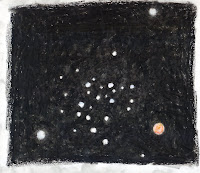We had clear skies Wednesday but not yesterday.
Wednesday Mars was almost in the Beehive. Just at the fringe of the Beehive.
The last time Mars was near the Beehive, if I remember right, was around 1998. Yesterday when Mars was directly in front of the Beehive we had cloudy skies.
Damn it.
Now I have to wait another ten years . . .
And Wednesday night the seeing was kind of strange. The sky was clear. Everything was easy to find. But colors were oddly off. Mars seemed kind of subdued. Iota Cancri actually seemed brighter than I remembered it, and the golden component seemed almost yellow and not gold.
Damn it again.
But I did a couple of pencil sketches right at the telescope to make note of what I was looking at. Yesterday I did an oil pastel sketch—again, just an impression!—of the scene visually. I still regard this as an experimental way of making images, but I am liking it more and more. Normally I’m so insecure and nervous about making images that I regard the actual process with something like trepidation. But this oil pastel approach to celestial scenes is actually fun for me. The process itself, I mean.
 I’m still working out a good procedure for doing this, that’s why I regard this as experimental.
I’m still working out a good procedure for doing this, that’s why I regard this as experimental.The way I did this image was to first mount my binoculars on a tripod. I’ve always read that a tripod mount for binoculars makes a tremendous difference and improves seeing with the binoculars almost magically. That turns out to be very true. Without the tripod mount, through my binoculars the Beehive looks like a smudge. With the tripod mount holding the binoculars steady I can make out the brightest individual stars of the Beehive with no problem.
I urge everyone interested in binocular astronomy to get a tripod mount for their binoculars.
Anyway, what I did was to first observe the Beehive through my mounted binoculars. I sketched the brightest stars of the cluster and the rough relationships between Delta and Gamma Cancri, the Beehive and Mars.
Then I observed the scene through my telescope at low power, 36x. I used the telescopic view to get a bit of a feel for the how to lay-out the dimmer stars of the cluster. But there are so many that, for the most part, I could have positioned the dimmer stars any way at all.
It is a bit awkward using binoculars and a normal telescope with the goal of drawing images because binoculars show a scene oriented ‘properly.’ My telescope, like most astronomical telescopes, shows a scene upside-down and sideways.
A long and generally pointless aside:
The upside-down and sideways thing is just the way optics work. That’s why astronomy images often include a phrase like, ‘south is up’ or ‘east is to the left’ or something similar—it lets the viewer know that what they’re seeing is a view through a telescope and not what they’d actually see in the sky in real life.
This was an issue for me when I posted “Whispering On The Moon.” Many published images of the Moon and published maps of the Moon are upside-down and reversed to make them look like what people see through telescopes. Also—[sighs]—the Moon undergoes what astronomers call ‘field rotation’ as it rises in the east, moves through the southern sky and sets in the west. That means the Moon’s north-south axis starts out in the east almost parallel to the horizon, becomes ‘normal’ and perpendicular to the horizon when the Moon is in the southern sky and then becomes almost parallel to the horizon when the Moon is low in the west. The bottom line is that the most ‘normal’ view of the Moon is when the Moon is in the southern sky and that is when the Sea of Serenity is in the upper right and the Sea of Clouds is in the lower left.
Anyway, so I’m thinking of getting what’s called an ‘image erector’ for my telescope. That’s an optical gizmo that attaches under the eyepiece. It degrades the image a tiny bit, but it creates a telescopic view that is similar to a binocular view, with the scene ‘correctly’ positioned up-and-down and left-and-right. They cost about $50-$75 so I’m not getting one right away, but it’s on my agenda of possible things to splurge on.
I’m pretty sure I’ll be using the same procedure in the future, roughing out a sketch based on a binocular view and then adding details based on the telescopic view.
I like this image a lot. I’ve exaggerated the size of Mars and many of the distance relationships. And I didn’t really capture the general lay-out of the open cluster as well as I would have liked. And I still haven’t gotten the hang of rendering the color properly so that the scanner captures the vivid intensity of the real-life scene. But even with those qualifications when I look at this it really does capture the impression of what I saw. It brings the reality of the scene back into my consciousness.
The things that trouble me are all areas that I believe—that is, I’m guessing, I’m hoping!—will be easy to improve upon as the summer goes on and I do many more oil pastel sketches.
Stay tuned! I had so much fun doing this image that I’m looking forward even more to tracking down other open clusters and getting more colorful doubles in view.
Open Clusters And Colorful Doubles
Pumpkin Mars In The New Myth Sky
Astronomy And Impressionism
No comments:
Post a Comment